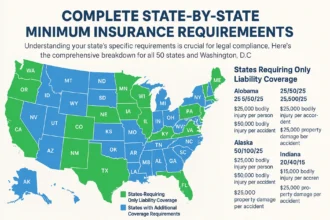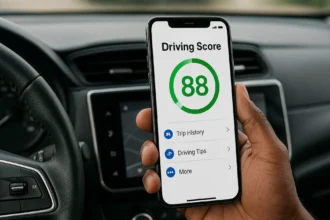
Are you paying too much for car insurance? If you’re like most Americans, you’re probably overpaying by hundreds or even thousands of dollars each year. The stark reality is that where you live can make your car insurance cost double what drivers in other states pay for identical coverage.
Compare the Best Insurance Rates Now →
Why Car Insurance Costs Vary So Dramatically Between States
The difference in car insurance rates between states isn’t just significant—it’s shocking. Drivers in the most expensive states pay nearly three times more than those in the cheapest states. Understanding why this happens is crucial to making informed decisions about your coverage and potentially saving thousands of dollars annually.
Location serves as the primary rating factor for car insurance companies, heavily influencing your premiums down to your specific ZIP code. Insurance companies analyze complex data sets including local accident rates, weather patterns, theft statistics, and repair costs to determine risk levels for each area.
The 10 Most Affordable States for Car Insurance in 2025
Based on comprehensive data analysis from multiple insurance sources, here are the states where drivers enjoy the lowest car insurance premiums:
| Rank | State | Average Monthly Premium | Average 6-Month Premium | Key Factors |
| 1 | Vermont | $109 | $654 | Low population density, minimal severe weather |
| 2 | New Hampshire | $119 | $715 | Rural roads, high credit scores, limited tort liability |
| 3 | Idaho | $121 | $729 | Low crime rates, fewer accidents, rural driving |
| 4 | Ohio | $122 | $732 | Competitive insurance market, moderate weather |
| 5 | Maine | $125 | $751 | Low traffic density, minimal urban congestion |
| 6 | Hawaii | $127 | $760 | Island driving, lower speeds, unique geography |
| 7 | North Carolina | $128 | $766 | State-regulated rates, competitive market |
| 8 | Wyoming | $132 | $795 | Lowest population density, minimal traffic |
| 9 | Massachusetts | $133 | $799 | Strong state regulation, competitive market |
| 10 | Indiana | $140 | $840 | Rural areas, reasonable repair costs |
Find Your State’s Best Rates →
What Makes These States So Affordable?
Geographic and Demographic Factors
The most affordable states for car insurance share several common characteristics that keep premiums low:
Low Population Density: States like Vermont, Wyoming, and Idaho have significantly fewer cars on the road, reducing accident probability and insurance claims.
Rural Road Networks: A higher percentage of driving occurs on highways rather than congested city streets, where accidents are more frequent and severe.
Weather Patterns: These states generally experience fewer severe weather events that can cause widespread vehicle damage, such as hurricanes, tornadoes, or severe hailstorms.
Crime Rates: Lower rates of vehicle theft and vandalism directly translate to reduced comprehensive coverage claims.
Economic Considerations
Lower Cost of Living: Repair costs, medical expenses, and legal fees are generally lower in these states, reducing the overall cost of claims.
Higher Credit Scores: Many of the most affordable states have residents with above-average credit scores, which correlates with lower insurance risk profiles.
Competitive Markets: States with numerous insurance companies competing for business often see lower rates due to market competition.
How State Regulations Impact Insurance Costs
No-Fault vs. At-Fault States
Understanding your state’s insurance laws is crucial for predicting costs. No-fault states require Personal Injury Protection (PIP) coverage, which can increase premiums but may reduce lawsuit-related costs.
At-Fault States in Top 10: Vermont, New Hampshire, Idaho, Ohio, Maine, North Carolina, Wyoming, Indiana
No-Fault States in Top 10: Hawaii, Massachusetts
State Minimum Coverage Requirements
Each state sets its own minimum coverage requirements, directly impacting baseline insurance costs:
- Vermont: 30/60/20 (higher minimums but competitive market)
- New Hampshire: 25/50/25 (optional insurance state)
- Idaho: 25/50/15 (lower property damage minimums)
- Ohio: 25/50/25 (standard minimums)
- Maine: 50/100/25 (higher minimums offset by low claims)
Compare Minimum vs. Full Coverage Rates →
Regional Analysis: Why Geography Matters
The Midwest Advantage
Five Midwestern states appear in the top 10 most affordable list, benefiting from:
- Stable weather patterns
- Lower population density
- Competitive insurance markets
- Reasonable repair and medical costs
New England’s Surprise Performance
Despite higher costs of living, Vermont, New Hampshire, and Maine rank among the most affordable due to:
- Strong state insurance regulation
- Lower accident rates on rural roads
- Seasonal driving patterns that reduce exposure
Mountain West Benefits
States like Idaho and Wyoming benefit from:
- Vast open spaces with lower traffic density
- Fewer severe weather events
- Lower crime rates
- Minimal urban congestion
Money-Saving Strategies for Any State
Even if you don’t live in one of the most affordable states, you can still reduce your premiums significantly:
Shop Around Regularly: Insurance rates change frequently. Compare quotes from multiple companies at least annually.
Bundle Policies: Combining auto and home insurance can save 10-25% on both policies.
Improve Your Credit Score: In states where it’s allowed, better credit can significantly reduce premiums.
Consider Usage-Based Insurance: Telematics programs can provide discounts up to 40% for safe drivers.
Increase Deductibles: Raising your deductible from $250 to $1,000 can reduce premiums by 15-30%.
Take Advantage of Discounts:
- Multi-vehicle discounts
- Good student discounts
- Safe driver discounts
- Military/veteran discounts
- Professional organization discounts
READ ALSO: Can I Insure a Car Not in My Name? Complete Guide for 2025 (Plus Legal Alternatives)
Common Mistakes That Increase Insurance Costs
Choosing Based on Price Alone
While finding affordable coverage is important, the cheapest policy isn’t always the best value. Consider:
- Claims handling reputation
- Financial stability ratings
- Customer service quality
- Coverage limitations
Maintaining Minimum Coverage Only
State minimum coverage often provides inadequate protection. Consider the financial risk of:
- Medical bills exceeding your liability limits
- Property damage claims surpassing coverage
- Lawsuit settlements beyond your protection
Not Updating Coverage After Major Life Changes
Life events that should trigger coverage reviews:
- Moving to a new state or ZIP code
- Getting married or divorced
- Adding teenage drivers
- Purchasing a new vehicle
- Changing jobs or retirement
Get Personalized Rate Quotes →
The Most Expensive States to Avoid
Understanding which states have the highest insurance costs helps put the affordable states in perspective:
| State | Average 6-Month Premium | Cost Factor |
| Florida | $1,819 | Severe weather, no-fault laws |
| Louisiana | $1,635 | High crime, frequent storms |
| Missouri | $1,521 | Severe weather, high claims |
| Kentucky | $1,430 | No-fault state, rural challenges |
| Nevada | $1,384 | High crime, tourist traffic |
Impact of Moving Between States
Planning Your Move
If you’re considering relocating, factor insurance costs into your decision:
Moving from California to Vermont: Potential savings of $456 per year
Moving from New York to Idaho: Potential savings of $502 per year
Moving from Florida to New Hampshire: Potential savings of $1,104 per year
Steps for Changing State Coverage
- Research New State Requirements: Understand minimum coverage and any mandatory additions like PIP
- Contact Current Insurer: Check if they operate in your new state
- Compare New Options: Get quotes from multiple companies in your new state
- Update Registration: Coordinate with DMV requirements
- Maintain Continuous Coverage: Avoid lapses that can increase rates
Expert Predictions for 2025 and Beyond
Rate Trend Analysis
Insurance industry experts predict:
- Continued Regional Disparities: The gap between expensive and affordable states will likely persist
- Climate Impact: States with severe weather may see increased rates
- Technology Integration: Usage-based insurance will become more common
- Regulatory Changes: Some states may adjust minimum coverage requirements
Emerging Factors
Electric Vehicle Impact: As EVs become more common, repair costs and availability will affect rates differently across states.
Autonomous Vehicle Preparation: States preparing for self-driving cars may see different rate structures.
Population Shifts: Remote work trends may affect which states remain affordable as population densities change.
READ ALSO: The 10 Cheapest Cars to Insure in 2025 (Save Up to $4,426 Annually)
Actionable Steps to Lower Your Car Insurance Today
Immediate Actions (Can Be Done Today)
- Get Multiple Quotes: Compare rates from at least 3-5 companies
- Review Current Coverage: Ensure you’re not over-insured or under-insured
- Ask About Discounts: Many people miss available discounts
- Consider Deductible Changes: Evaluate if higher deductibles make sense
Medium-Term Strategies (Next 3-6 Months)
- Improve Credit Score: Pay down debt and correct credit report errors
- Complete Defensive Driving Course: Many states offer premium discounts
- Consider Vehicle Changes: Some cars cost significantly more to insure
- Evaluate Coverage Needs: Adjust coverage as vehicles depreciate
Long-Term Considerations (Next 1-2 Years)
- Monitor Rate Changes: Set calendar reminders to shop annually
- Consider Relocation Impact: Factor insurance costs into moving decisions
- Build Claims-Free History: Maintain safe driving record
- Review Life Changes: Update coverage as circumstances change
Start Saving on Car Insurance Today →
State-by-State Comparison: Full Coverage vs. Minimum
Understanding the cost difference between minimum and full coverage in affordable states:
| State | Minimum Coverage | Full Coverage | Difference |
| Vermont | $427 | $654 | $227 |
| New Hampshire | $468 | $715 | $247 |
| Idaho | $476 | $729 | $253 |
| Ohio | $478 | $732 | $254 |
| Maine | $490 | $751 | $261 |
The relatively small difference between minimum and full coverage in these states makes comprehensive protection more affordable.
Trust Indicators and Industry Recognition
Data Sources and Methodology
This analysis combines data from multiple authoritative sources:
- The Zebra’s comprehensive rate database
- National Association of Insurance Commissioners (NAIC) reports
- State insurance department filings
- Bureau of Economic Analysis income data
- U.S. Census Bureau population statistics
Expert Validation
Insurance industry professionals consistently identify these states as offering the best value for car insurance coverage, balancing affordability with adequate protection.
Conclusion: Your Next Steps to Affordable Car Insurance
The most affordable states for car insurance offer drivers significant savings opportunities, but location is just one factor in your overall insurance costs. Whether you live in Vermont with its $654 average annual premium or you’re stuck in Florida paying $1,819, you have options to reduce your costs.
The key is taking action. Insurance rates change daily, and the longer you wait, the more money you’re potentially leaving on the table. Start by comparing quotes from multiple companies, regardless of your state. Even in expensive states, shopping around can save you hundreds or thousands of dollars annually.
Remember that the cheapest option isn’t always the best value. Focus on finding the right balance of coverage, service, and price for your specific situation. With the strategies outlined in this guide, you can make informed decisions that protect both your finances and your peace of mind.
Rate changes happen daily—see what you qualify for today.
Get Your Free Quote Comparison →
This article is updated regularly to reflect the latest insurance rates and industry trends. Last updated: July 2025
In another related article, Most Expensive States for Car Insurance: Complete Guide to High-Cost Auto Insurance in 2025





